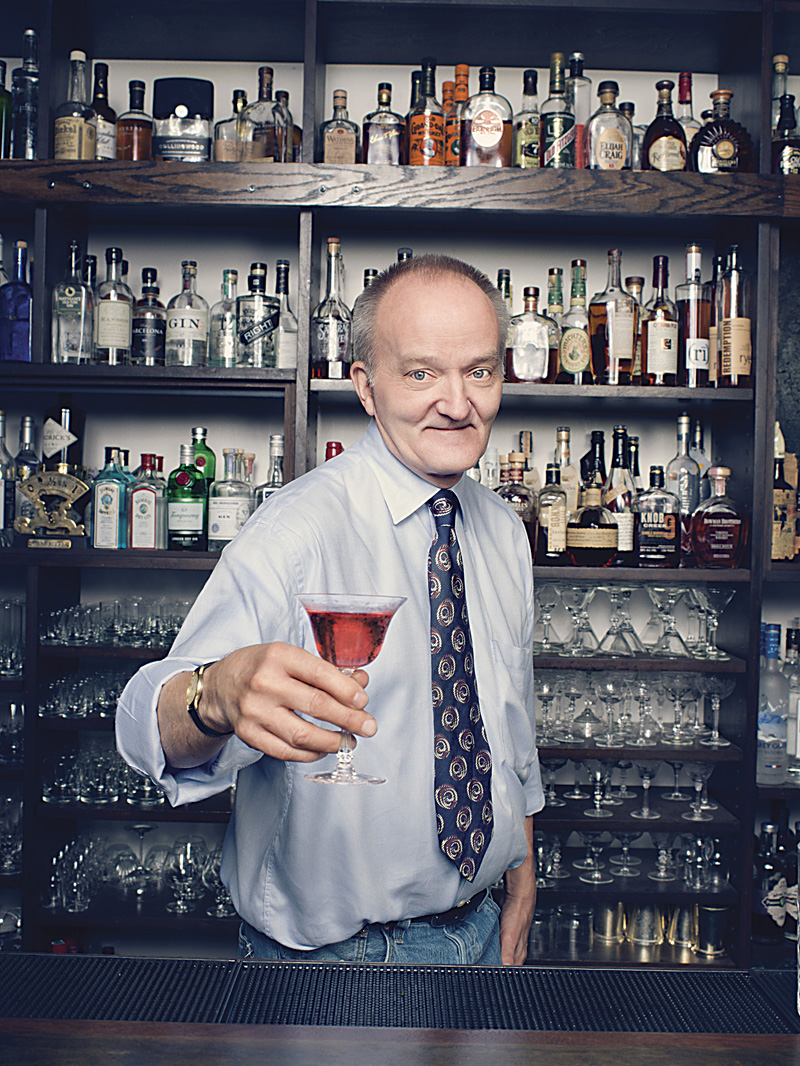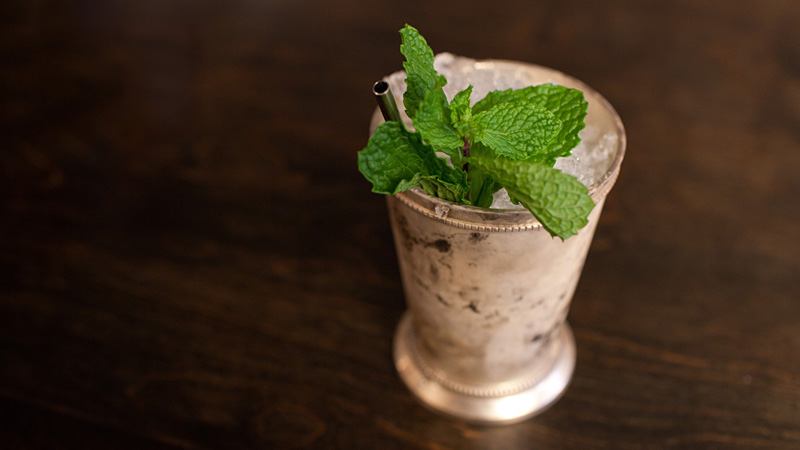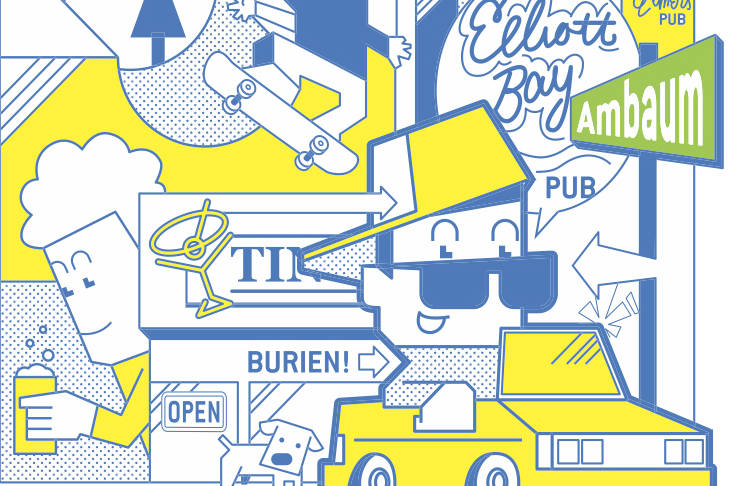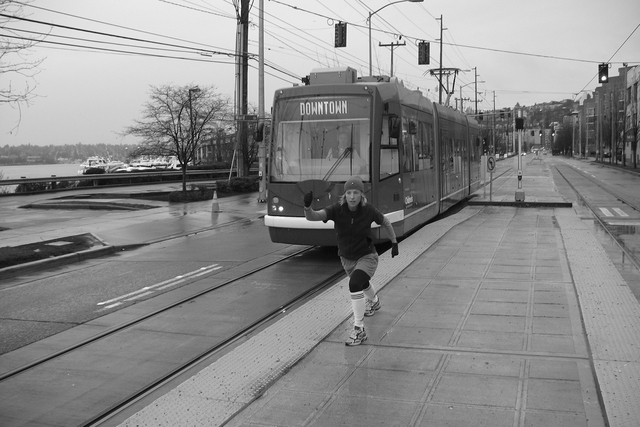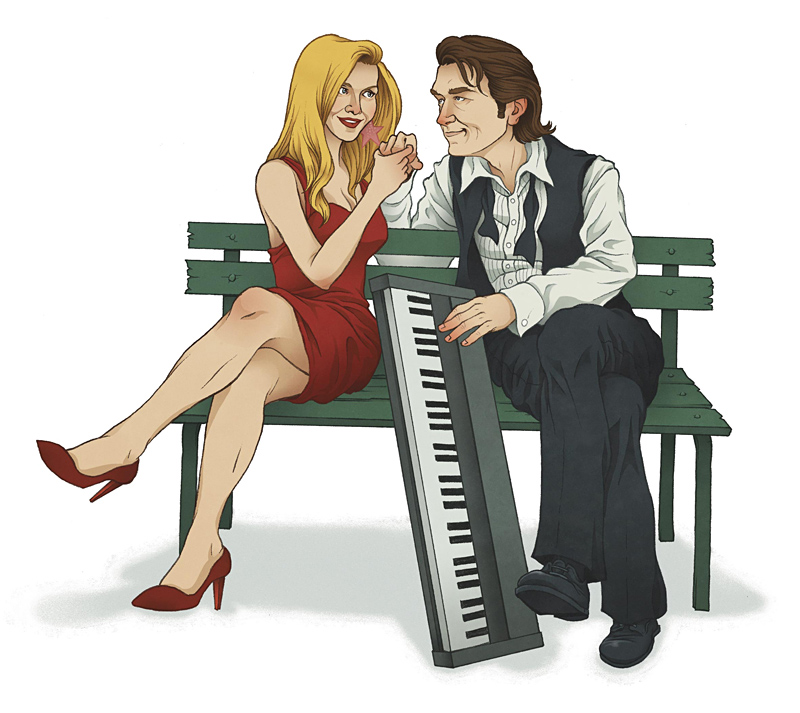Everybody has a Murray Stenson story. Robert Hess’ goes like this:
A self-proclaimed “cocktail evangelist” who works for Microsoft, Hess had been prodded by his drinking buddies to visit Il Bistro, a restaurant in Pike Place Market. In particular, they wanted Hess to test the wiles of a bartender named Murray Stenson.
“I finally got around to ordering an Old Fashioned from Murray,” says Hess of the experience, which occurred in the mid-’90s. “I’m halfway through my drink and my phone rings, and I have to leave. I didn’t get the chance to tell Murray my name or talk to him at all. I didn’t get back to Il Bistro for another year. When I ordered my second drink, Murray said, ‘You must like that seat. That’s the same seat you sat in last time.’ He was right: It was the exact same seat. I could remember that, but to have a bartender remember that after thousands of customers, that’s what Murray does.”
Jamie Boudreau also has a Murray Stenson story. One of the best-known mixologists on the West Coast, Boudreau first stopped into the Zig Zag around the time he moved from his native Vancouver, B.C., to Seattle in 2006. Upon introducing himself to Stenson, who’d moved on from Il Bistro, the latter quoted verbatim a blog post Boudreau had recently written.
“He’s all about hospitality,” says Boudreau, who after stints at Vessel and Tini Bigs now owns Canon, undoubtedly the rookie of the year within Seattle’s 2011 bar ecosystem. “And, of course, there’s his memory.”
There are great memories, and then there is Stenson’s memory. To have any memory at all after 40 years in the bar biz is a feat unto itself. To boast one that features the eidetic attributes of Asperger’s without the nasty side effects defies conventional wisdom.
In early October, Boudreau added Stenson to his crew at Canon, elevating what was already a standout roster of bartenders to the drink-pouring equivalent of Blind Faith. Upon hiring him, Boudreau, widely considered the city’s most talented cocktail craftsman, offered to bar-back for Stenson, exempt him from measuring portions of liquor, and install “a second shit ice machine” to make him feel like he was back at Zig Zag, from which he parted company last spring after a decade-long tenure that put both the bar and Stenson on the must-sip maps of aficionados nationwide.
Three months into his stint at Canon, where the bar is literally painted with bitters, Stenson has made Boudreau second-guess himself. Not because Stenson has failed to live up to expectations, but because he’s insisted upon conforming—measuring portions for the first time in 25 years and eschewing the familiar ice while working side-by-side, not front-to-back, with Boudreau every Sunday evening, when people regularly line up at Canon’s nondescript front door to secure a seat at the bar, which often fills as soon as it opens. Hence, Boudreau is now considering unloading that second shit machine.
“I’m a team player,” says Stenson of his refusal to exploit Boudreau’s loopholes. “I want to learn.”
Of Stenson’s work ethic, Kacy Fitch, his former boss at Zig Zag, says, “He never took a vacation.” When Fitch offered Stenson the opportunity to skip Friday-night shifts, which by the end of Stenson’s tenure regularly attracted a headache-inducing mob of patrons, Stenson, 62, demurred. “He said, ‘I can work as hard as any of these young guys,’ ” and kept right on working Fridays.
On a recent Sunday at Canon, Stenson is dressed in blue jeans and a button-down shirt, posing quite the casual contrast to Boudreau, a handsome block of a man whose retro finery harkens back to Repeal Day, which is memorialized in framed newspaper clippings on the regal bar’s walls. For booze geeks, seeing this pair work a shift together is tantamount to having seen Hendrix and Jimmy Page jam in a basement club in London. The two couldn’t be more different: While Stenson is heralded for his customer service, knowledge of classic cocktails, and efficiency, Boudreau is known as the dogmatic, cutting-edge mixologist who refused to pour frou-frou drinks while working at Vessel, a polarizing downtown hooch haven which enjoyed a short but groundbreaking run in the latter half of the aught-naughts (while the bar’s been closed for more than a year, a reboot is in the offing).
“They are my two favorite bartenders in Seattle,” says Paul Clarke, a regular contributor to Imbibe magazine who maintains a blog called The Cocktail Chronicles. “Jamie is a technical wizard and obsessively detail-oriented. Murray is a bartender—there’s a certain flexibility. At Zig Zag, there was an improvisational factor to what he was doing. But neither of them imposes their will on the other. That’s what makes it work.”
At Canon, one might expect sonatas to dominate the sound system, but Boudreau has shrewdly programmed against type, blaring the likes of Zeppelin and the Stones. He has been somewhat schizophrenic in describing his vision for the bar, saying in one breath that he “just want[s] it to be a neighborhood bar,” while in the next proclaiming that he’s aspiring to make Canon “one of the nation’s elite bars.” He might ultimately achieve both objectives: The response thus far to Canon’s opening has been “way beyond anything I thought it would be,” says Boudreau, who’s had to double his staff to keep up with demand in his 48-capacity space, which can endure up to seven nightly turns.
When people order a drink from Stenson, they hardly ever request something standard, if they request anything at all. Rather, Stenson’s customers typically specify a type of liquor (or not) and expect that he make them the best drink they’ve ever had in their lives. At Canon, such ambiguity is encouraged on the house cocktail menu, with a $10 “Shrouded Roulette” option beckoning customers to “tell us your base spirit and we’ll create a mystery.”
Only for Stenson, who in the ’80s began voraciously consuming every classic cocktail manual he could get his hands on, there are no mysteries. When a patron specifies only a region (Mediterranean) she’d like her cocktail to evoke, Stenson thinks hard for all of three seconds before replying, “OK, got it.”
“Partially, it’s his own damn fault, because he’s such a good sport about it,” says Clarke of customers’ tendency to demand spontaneity with Stenson’s every stir.
Seattleites haven’t been the only ones to ascribe superstar status to Stenson: Both Esquire and New Orleans’ Tales of the Cocktail convention recently named him America’s best bartender.
“Nationally, any bar of any measure knows who Murray Stenson is,” says Andrew Friedman, who owns Liberty and currently chairs the Washington State Bartenders Guild. “The advent of the cocktail scene made people recognize who the greats were in different cities. For Murray, it’s embarrassing and a pain in the neck, but when he was named Bartender of the Year at Tales of the Cocktail, it was because of years of people whispering about this guy, this groundswell of interest.”
Yet while Stenson takes great pride in being an excellent bartender, his vocational journey differs dramatically from those of young guns like Boudreau, Friedman, and Rob Roy’s Anu Apte, the premier female character of Seattle’s cocktail renaissance. Stenson fell into bartending absent any premeditation, and after bouncing from bar to bar during the first half of his career, he’s never abandoned the clock-puncher’s humility that so endears him to customers. It’s a demeanor that doesn’t quite square with how celebrated he’s become.
“The more I get to know him,” says Clarke, “the more I realize I don’t really know him.”
Seated at a window table at Oliver’s, the majestic Mayflower Park Hotel bar which more closely resembles a ballroom than a watering hole, Stenson is instantly recognized by the host as happy hour kicks off. He is svelte and articulate, with short white hair, an elfin face, and a nervous but conversational disposition. After being presented with a small glass carafe of peanuts by a cocktail waitress, Stenson settles on a Negroni, which rivals a Manhattan or beer as his favorite drink to order, if not make.
As a customer, he counts the Wedgwood Broiler among his favorites, although he hops around to the point where he doesn’t have a regular haunt. To Stenson, what makes a great bar is hospitality and comfort, plain and simple. And Oliver’s, where Stenson worked for a spell in the ’70s, has both to burn. (Oliver’s, which opened in 1976, was among the first full-service Washington state bars with windows, which until then had been verboten in all but beer-and-wine-only taverns.)
“This bar has a great feel to it,” says Stenson of Oliver’s, among the few bars in town to offer gratis appetizers during happy hour (Bernard’s, also an ideal Stenson destination, is another). “It’s comfortable, and they have good people working.”
Born in the remote northeast Washington town of Colville in 1949, Stenson was 12 when his family moved to Kirkland, which at the time “was really blue-collar— Bellevue’s ghetto,” he says. His father was a schoolteacher and principal, and the Stensons enjoyed what Murray describes as a “lower-middle-class” upbringing, which taught him to be frugal. Hence, Stenson had amassed a comfortable sum of savings when it came time to move out of the family home.
After dropping out of Shoreline Community College, Stenson “somehow never got drafted to Vietnam” and worked as a shoe salesman at JC Penney before moving on to jobs with a door manufacturer and as a Safeway night stocker. Living in a small apartment in Kirkland, he decided to take a summer off. During his sabbatical, he spent the bulk of his time lounging around the complex’s pool. One day, the building owner’s son approached Stenson, who’d never tended bar before, about a gig at Benjamin’s, a Bellevue restaurant he managed. Stenson took him up, and spent a year tending bar before quitting as an act of solidarity when his girlfriend was fired.
After their departure, Stenson drove his girlfriend to an interview at Henry’s Oyster Bar on Capitol Hill. While waiting for her interview to end, Stenson was unexpectedly offered a job, which he accepted. He stayed at Henry’s for a year before moving on to Oliver’s, then to virtually any bar he pleased whenever he got antsy. “There were so many bars that you could give your notice and walk to the next block and get another job,” says Stenson, whose immediate post-Oliver’s gigs included stints at Ray’s Boathouse and Daniel’s Broiler, among a dizzying flurry of others, many long since shuttered.
Of the first half of his career, Stenson says, “That was the disco era, and drugs were pretty prominent. By the mid-’80s, there was a lot of cocaine. But I was a music junkie. It was always like, ‘I can buy coke for $120, or I can go buy $120 worth of vinyl.’ ” Without fail, he chose vinyl. His collection today totals some 6,000 records, many of which he keeps in a downtown storage unit, as his Queen Anne one-bedroom apartment, which he shares with a longtime girlfriend several years his junior, lacks the capacity for the belongings of a self-avowed “pack rat and huge reader.”
But the coked-out ’80s did do Stenson one favor: They taught him how to utilize types of booze he otherwise might not have. While working at a since-closed Belltown bar he declines to name, Stenson recalls how the general manager and his cronies would regularly snort their way through the till, to the point where they didn’t have the money to reorder name whiskeys and key supplementary beverages. Hence, Stenson was left to craft passable cocktails with marginal Canadian whiskey and whatever was left gathering dust on the shelf, adding a keen sense of kitchen-sink improvisation to his burgeoning knowledge of the classics.
Stenson doesn’t own a car, although he rents a vehicle from Avis twice a month to run high-volume errands. He spent Thanksgiving dining on sushi at Maneki before taking in a screening of The Descendants. A “huge stereo geek,” Stenson collects vintage hi-fi equipment. He has been married twice and has two children. (“I had sex twice; it was great.”) His daughter is a primary-school teacher in West Seattle, while his son, just out of the Navy, paints houses and goes to Shoreline, his dad’s almost–alma mater.
While working at Daniel’s, a waiter gave Stenson the nickname Mur the Blur, after a well-known local racehorse of the time. With a record of 9-6-4 in 40 starts and career earnings of $255,110, the thoroughbred Murrtheblurr, according to Emerald Downs spokesman Vince Bruun, was a Kentucky-bred with great speed who lacked the stamina to win at the sport’s more prestigious distances. He finished a respectable fifth in the 1980 Longacres Mile as a 3-year-old, and was once trained by the legendary D. Wayne Lukas under the ownership of Dan Agnew, a Clark County resident who went on to be inducted as a breeder in Washington state’s Horse Racing Hall of Fame.
“He was named after a friend of mine named Mike Murray,” says Agnew. “His nickname was the Blur because he was quick and fast and never stayed in one place for very long. He was a fuel salesman in Centralia.” As for the horse, “He was very precocious, very active, and had a real personality. He was always on edge, which was very fortuitous, because he took on the personality of the guy I named him after.”
As for that guy and where he got his nickname, Murray recalls: “I was playing on a baseball team with a guy who was a starting guard on the [Washington State University] basketball team. He could outrun me backwards. He was making fun of me running the bases and said, ‘Mur the Blur!’ After college, I became friends with Dan, and he named his horse after me. I went to the paddock before a race, and he tried to bite me. I said, ‘OK, that’s it—I’m putting $100 on his nose to win.’ “
He won.
So has the original Mur the Blur ever been served a drink by the bartender Mur the Blur? “I’m a Cougar, so I did drink a lot,” concedes Murray. But alas, he doubts he’s ever ordered a cocktail from Stenson, with his big-city drinking excursions mostly limited to bars within close proximity of Husky Stadium on Apple Cup Saturdays.
When people speak of Seattle’s cocktail awakening, their focus inevitably shifts to Vessel, which opened in 2006 next to the 5th Avenue Theatre before flaming out in 2010. Boudreau was lured from a prestigious Vancouver, B.C., bar to build Vessel’s drink program, and toward the end of his tenure he hired Apte away from BOKA to join a team that included Keith Waldbauer, now Friedman’s partner at Liberty.
It was at Vessel where Boudreau and his cohorts would famously refuse to pour cosmopolitans, lemon drops, or shots, thus screwing over legions of intermission tipplers intent on sustaining a buzz through the second half of Grease. “When people would order a cosmo, we would try to steer them toward something different,” says Boudreau. “We were actively trying to convert people at Vessel. I really think Vessel changed the scene in the city.”
“[Vessel] was the first bar to just go for it, to just truly be a cocktail bar,” adds Apte, who bought Rob Roy (formerly Viceroy) in 2009 from Linda Derschang and quickly set to eradicating the Belltown bar’s dance-on-the-banquette set. “A lot of people were doing cocktails, but not making that sort of a statement.”
In announcing that he just wants Canon to be a neighborhood bar and touting his beer and wine specials—although it must be said that ordering beer or wine at Canon is akin to rooting for Ray Allen to set screens instead of take jump shots—it’s evident Boudreau no longer finds much use for his hardheadedness of yore. (Clarke considers an interim gig at Tini Bigs, where Boudreau had to make “Dirty Girl Scouts for sorority girls” and “wasn’t in his comfort zone, making foams and gels for people” to have been “probably the best thing that ever happened to [Boudreau].”) After Vessel hit the scene, Boudreau saw bars like Liberty, Spur, Tavern Law, and Licorous, Canon’s predecessor in its 12th Avenue space, “buy better equipment and step up their game.” Since he moved south in 2006, Seattle’s cocktail culture has grown “by leaps and bounds. Now people are happy to put themselves in the bartender’s hands.”
Yet the notion that Seattle traded its flannel and microbrew for ascots and absinthe a mere five years ago is a faulty one. In truth, the foundation for Seattle’s cocktail renaissance was enabled by the ’90s tech boom, compelling suddenly flush youngsters to reach for higher shelves at a pair of Pike Place Market bars: the Zig Zag and Il Bistro. And the man tending those bars just happened to be Stenson.
When Kacy Fitch and Ben Dougherty signed on as bar managers at the Zig Zag Café in 1998, it was a pizzeria which served only beer and wine and had no physical bar area. Fitch and Dougherty were enlisted to build one from scratch. In so doing, they were governed by a simple dictum.
“We didn’t necessarily build the bar to entice him to work here, but we built the bar always asking, ‘What would Murray do?’ ” says Fitch, who with Dougherty bought the bar outright in 2001 and quickly hired Stenson, who’d been collecting paychecks at Typhoon (which recently reopened as Dulces Bistro) and the Corner Bar (now the Whisky Bar) since ending his decade-long reign at Il Bistro. “The bar was built for bartenders by bartenders—not by architects. Everything is within two or three steps. We wanted to have the most spirits known to mankind.”
Once the bar was constructed, Robert Hess paid the Zig Zag a visit after a bartender at Marco’s told him that Fitch and Dougherty “were cocky, and thought they could make anything,” recalls Hess. At the time, Hess hopped from bar to bar putting bartenders through an infamous three-drink test he knew full well they would fail. He’d first order an Old Fashioned, then ask the bartender to make him a drink of his or her choice, then request an obscure concoction called the Aviation, which called for maraschino liqueur.
“Ben was behind the bar and Kacy was sitting at the bar doing the books,” recalls Hess of his first trip to the Zig Zag. “Ben made a fabulous Old Fashioned”—no small feat in Seattle at the time, when screwdrivers made with fresh-squeezed orange juice were considered exotic—”and for the personal specialty, made me something that was great. For the third drink, I asked for an Aviation. They said, ‘What’s that?’ The next day I stopped by again, and they had a bottle of maraschino liqueur. In 24 hours, they made the effort to track down this bottle that was not stocked in liquor stores in 1998. That’s what clued me in that the Zig Zag was something special. Soon after that, they got Murray on board, and it became even more special.”
“Even if Murray’s drinks were dive-bar swill, he would still be a great bartender,” says Hess. “It’s not just the fact that he makes great cocktails or has an encyclopedic knowledge of ingredients. When you sit at his bar, you get to know the customers at his bar a lot easier. It kind of creates a magical atmosphere.”
“He gets the most awkward people imaginable to sing like birds and come back,” adds Stenson’s protégé, Zig Zag bartender Erik Hakkinen.
Like Hess, Boudreau, and virtually everyone else who’s been poured a drink by Stenson over the years, Fitch has a story. Only his story doesn’t involve just one anecdote, but rather a long, mutually beneficial relationship cultivated over many years spent “paying tuition over the bar” to Stenson as a customer at Il Bistro. When Fitch and Dougherty started hanging out there, “[Stenson] was the game in town,” recalls Hakkinen. “The Bistro was nuts.”
The tech millionaires were obsessed with scotch, and “Murray had a gajillion scotches,” says Fitch, who notes that Stenson emphasized how important it was, in that pre-puritanical era, to have a flame awaiting smokers even before they’d reach for their cigarettes. “He was a mentor, and he was our master,” says Fitch.
Ultimately, Fitch and Stenson agree that the reason Stenson left the Zig Zag last spring was that the crowds who came to see him had grown too unwieldy.
“Once the hype got out of control,” says Clarke, who cites 2008 as the year all hell started to break loose, “it was like you had tour buses pulling up.”
“The pace last year was unheard-of,” says Hakkinen. “I haven’t seen that in a place this size anywhere, except maybe New York City.”
“It got to the point where it was brutal,” admits Stenson.
After rumors that he’d be manning the bar at RN74 failed to materialize (Stenson was in negotiations to work there, but a shoulder injury knocked the union off course), Stenson did some consulting and traveled to France. It wasn’t until he started at Canon in October, Fitch says, that the Zig Zag saw business drop off significantly, which nevertheless can be viewed as a snifter half-full.
“People can get a seat and the staff isn’t frazzled,” says Fitch. “The only thing that’s bad about it is the bottom line.”
When Murray Stenson was announced as Bartender of the Year at the July 2010 Tales of the Cocktail event in New Orleans, one person was conspicuously absent: Murray Stenson. Rather than travel to accept the award himself, he asked Clarke to do it for him.
“He had to work,” explains Clarke, “and any kind of event where Murray is asked to get onstage and accept an award guarantees he won’t be within 1,000 miles of that event.”
Even though he no longer works there, Stenson still drops by the Zig Zag for drinks once or twice a month, often during Thursday “guys’ night out” gatherings organized by a group of high-tech workers. On a recent Thursday night, the group planned to show up in tuxedos. Stenson shows up a shade after 5 in anticipation of their arrival. Stationed behind the bar, Hakkinen also expects his mother, who’s spent the bulk of the day at a Wheel of Fortune audition up the road at the Sheraton, to pop in at some point.
Seeing him enter, Hakkinen places a “Reserved” sign in front of the seat Stenson is angling for. Upon sitting at the bar, Stenson wonders why there’s a missing letter on the placard. “It used to say ‘Preserved,’ ” he quips.
As he and Hakkinen set to catching up, a young Asian couple seated nearby recognizes Stenson, then offers to buy him a drink. Stenson thanks them, but declines. “I’ll take a rain check,” he says, and then orders a pint of Maritime ale.
After his first sip, he’s approached by a waitress who looks like Taylor Swift. She asks Murray if he’s “still allowed in here” before embracing him warmly, then informs him that she’s just moved in with her boyfriend, who’s 12 years her senior. Stenson, whose girlfriend is “basically half [his] age,” offers the opinion that age is of no import, and wishes her the best.
Stenson is renowned for offering bellied-up patrons surprise samplers of unfamiliar liquor, a trait Hakkinen has inherited, offering his former cohort a sip of Buffalo Trace whiskey before pulling out a bottle of Stroh, a 160-proof Austrian rum that Stenson accurately describes as tasting “like a butter-rum Life Saver.” While at Il Bistro, Stenson used Stroh as a prop, turning a wine glass upside down, pouring a dollop of the rum on the upturned bottom, and lighting it so customers could ignite their cigars.
“It was a great presentation,” Stenson proclaims, as assured a statement as America’s Best Bartender is ever apt to utter.
